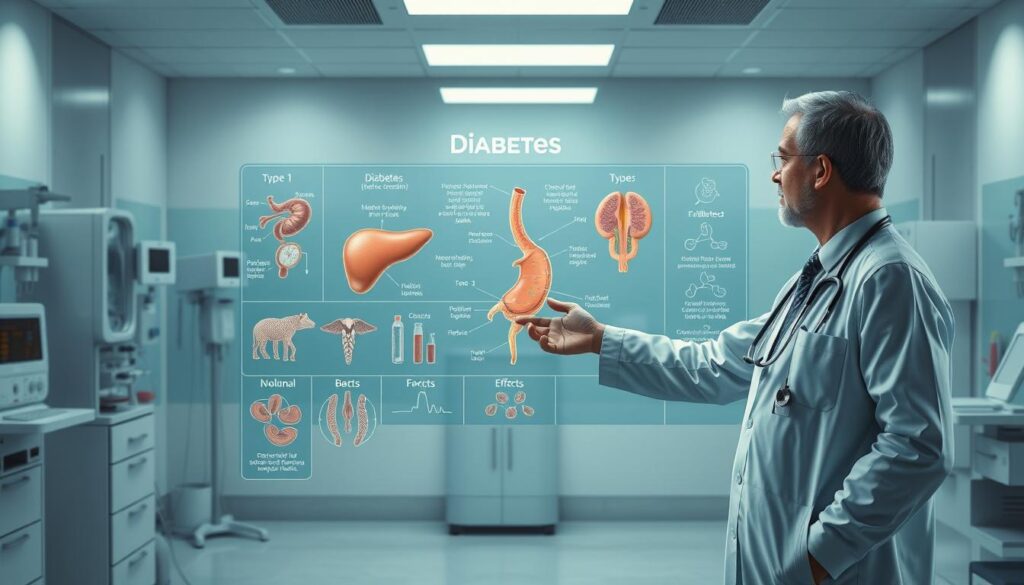Did you know over 30 million people in the United States have diabetes? About 1 in 4 don’t even know they have it. This shows how vital it is to know about the different types of diabetes. You might wonder, what are these types and how do they affect our bodies?
The main types are Type 1, Type 2, and Gestational. Each has its own way of impacting our health.
Learning about the different types of diabetes is key to managing it well. So, how many types are there, and what makes them different? In this article, we’ll explore the various forms of diabetes. This will help you understand this complex condition better.
Key Takeaways
- There are several types of diabetes, including Type 1, Type 2, and Gestational.
- Understanding the different types of diabetes is crucial for effective management and treatment.
- Type 2 diabetes is the most common form of diabetes, accounting for 90-95% of all diagnosed cases in the United States.
- Gestational diabetes occurs in about 2-10% of pregnancies, affecting hundreds of thousands of women across North America each year.
- Knowing how many types of diabetes are there and the different types of diabetes mellitus can help you take control of your health and make informed decisions about your care.
- Diabetes affects people of all ages, and the prevalence of diabetes significantly rises with age, with around 26% of those aged 65 years or older having the condition.
- Lifestyle changes can help delay or prevent the progression to Type 2 diabetes, for those with prediabetes.
Table of Contents
Understanding the Basic Classification of Diabetes
It’s key to know the different types of diabetes and how they affect the body. You might have heard of diabetes type 1 vs type 2. There’s also gestational diabetes. The main types are Type 1, Type 2, and Gestational, each with its own traits and causes.
Blood sugar is very important in diabetes. High levels can lead to serious health issues. About 37.3 million people in the U.S. have diabetes, with Type 2 making up 90 to 95 percent of cases. Diabetes classification is based on how well the body uses insulin, a hormone that controls blood sugar.
What Defines Diabetes Mellitus
Diabetes mellitus happens when the body can’t make enough insulin or use it well. This causes high blood sugar, which can harm organs and tissues. The insulin secretion capacity of those with type 2 diabetes gets worse over time. It’s vital to manage it with lifestyle changes and medicine.
The Role of Blood Sugar in Diabetes
Managing blood sugar levels is crucial in diabetes. You can use continuous blood glucose monitors to track your levels all day. Knowing about diabetes classification and blood sugar helps you control your condition. This reduces the risk of serious health problems.
How Many Types of Diabetes Are There: A Complete Overview
There are many kinds of diabetes, each with its own traits and treatments. The most common types are Type 1, Type 2, and Gestational diabetes. There are also rarer types.
About 38 million adults in the U.S. have diabetes. Yet, 1 in 5 adults don’t know they have it. Knowing the different types of diabetes is key to managing the condition.
Some important facts about diabetes are:
- Type 2 diabetes makes up 90% to 95% of all cases.
- Gestational diabetes occurs in 2% to 10% of pregnancies.
- More than 80% of people with prediabetes don’t know they have it.
Knowing about the kinds of diabetes helps in managing and treating it. Recognizing the types of diabetes and their risks helps people stay healthy. An overview of diabetes types helps everyone understand and take care of their health.
Type 1 Diabetes: The Autoimmune Condition
Exploring how many types of diabetes are there leads to understanding types of diabetes mellitus. Diabetes type 1 is a chronic condition. It happens when the body’s immune system attacks the insulin-producing cells in the pancreas.
Studies show that diabetes type 1 rates vary by region. For example, Sardinia and Finland have rates of 36.8 and 36.5 per 100,000, respectively. In the United States, it makes up about 5-10% of diabetes cases.
People with diabetes type 1 may feel thirsty, urinate a lot, get tired easily, and see blurry. They need insulin therapy, which can be given by injection or pump. Eating well and exercising regularly also help keep blood sugar levels stable.

Diabetes type 1 often comes with other autoimmune diseases. For example, autoimmune thyroid disease affects 17-30% of those with diabetes type 1. Knowing about diabetes type 1 helps manage it better and improve life quality.
| Region | Incidence Rate per 100,000 |
|---|---|
| Sardinia | 36.8 |
| Finland | 36.5 |
| United States | 12.2 |
Type 2 Diabetes: Understanding the Most Common Form
Type 2 diabetes is the most common form of diabetes. It makes up about 90-95% of all diabetes cases worldwide. When you have type 2 diabetes, your body doesn’t use insulin well. This hormone helps control blood sugar levels.
Managing type 2 diabetes is possible through lifestyle changes. You can lose weight, eat healthy, and exercise often.
There are several risk factors for type 2 diabetes. These include:
- Obesity
- Physical inactivity
- Family history
- Age (45 or older)
- Certain ethnic groups (African Americans, Hispanics or Latinos, American Indians, and Alaska Natives)

Type 2 diabetes is a serious condition. It can cause heart disease, vision loss, and kidney disease if not managed. Regular blood sugar checks and lifestyle changes can help manage it.
By understanding different types of diabetes, you can start managing your condition. This improves your overall health.
Gestational Diabetes: Diabetes During Pregnancy
Gestational diabetes happens during pregnancy and usually stops after the baby is born. It’s one of the kinds of diabetes that can occur. Knowing about its risk factors and how to manage it is key. About 8% of women who had a live birth got gestational diabetes in 2021.
When we talk about how many types of diabetes are there, gestational diabetes is important. Risk factors include being overweight, having a family history, and being older than 25. Women over 25 are more likely to get gestational diabetes than younger women.
To manage gestational diabetes, eating healthy and exercising are important. Women with this condition might also need insulin or medication. It’s important to know that it can raise the risk of getting type 2 diabetes later.
After pregnancy, it’s important to check for diabetes 4 to 12 weeks later. Women with gestational diabetes should also try to lose 5% of their weight if they’re overweight. They should aim for at least 150 minutes of exercise per week.
| Risk Factor | Description |
|---|---|
| Obesity | Being overweight or obese increases the risk of gestational diabetes |
| Family History | Having a family history of diabetes increases the risk of gestational diabetes |
| Age | Women older than 25 years are at a greater risk for developing gestational diabetes |
Less Common Types of Diabetes: From Monogenic to Drug-Induced
There are many types of diabetes, not just Type 1 and Type 2. Monogenic and drug-induced diabetes are less common. They can be caused by genetic mutations or certain medicines. Knowing about these types can help you manage your diabetes better.
Monogenic diabetes is rare and caused by a genetic mutation. It can be managed with diet alone. But, other types need pills or insulin. Drug-induced diabetes can happen from medicines like glucocorticoids and tacrolimus. Always talk to your doctor about the risks of your medicines.
There’s also maturity-onset diabetes of the young (MODY). It’s rare, affecting less than 5% of people with diabetes. It often runs in families for generations. Knowing about these types can help you manage your diabetes better.
Genetic defects can also cause diabetes. Down’s syndrome, Klinefelter’s syndrome, and Turner’s syndrome are examples. Recognizing these signs early can help prevent problems. Remember, knowing about diabetes types can empower you to manage your health.
Conclusion: Managing Your Diabetes Risk and Understanding Your Type
Knowing about the different types of diabetes is key to staying healthy. Eating well, exercising often, and talking to your doctor are important steps. They help you manage your diabetes risk and control your health.
If you have type 1 diabetes, type 2 diabetes, or another type, learning about it is vital. Keep track of your blood sugar, take your meds or insulin as told, and you’ll do great. This way, you can avoid serious health problems.
Understanding types of diabetes and your risk helps you stay well. Use the help and advice you get, and work with your doctor. Together, you can make a plan to manage your diabetes well.
FAQ
How many types of diabetes are there?
The American Diabetes Association lists several main types. These include Type 1, Type 2, Gestational, and Prediabetes. There are also rarer types like monogenic and drug-induced diabetes.
What is the basic classification of diabetes?
Diabetes is split into types based on blood sugar and insulin. Type 1 is when the body attacks insulin-making cells. Type 2 is when the body resists insulin.
How do doctors classify the different types of diabetes?
Doctors look at several factors to classify diabetes. They consider the cause, age of onset, and how well the body uses insulin.
What is the difference between Type 1 and Type 2 diabetes?
Type 1 diabetes is an autoimmune attack on insulin-making cells. Type 2 is when the body resists insulin.
What is Gestational diabetes?
Gestational diabetes happens during pregnancy and often goes away after. It’s crucial for women to control their blood sugar to keep both mother and baby healthy.
What are the less common types of diabetes?
There are rarer types like monogenic diabetes, caused by a genetic mutation. Drug-induced diabetes also exists, caused by certain medications.
How useful was this post?
Click on a star to rate it!
Share this article:
Meet Gluco 6
Blood sugar balance supplement
Tired of Type-2 controlling your life or worried that persistent high blood sugar may turn into something worse? Then yes, Gluco6 is right for you.
Gluco6 has already provided amazing blood sugar assistance for men and women in their 30s, 40, 50s and even 80s. Because it was formulated based on cutting-edge science and groundbreaking ingredients, Gluco6 is engineered to rapidly assist even the most erratic blood sugar levels.





